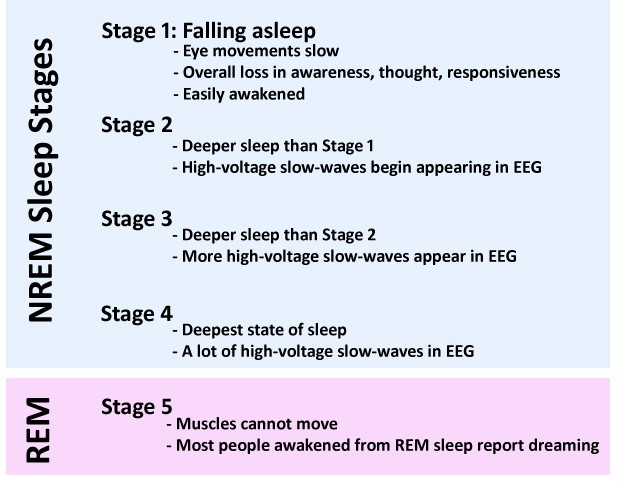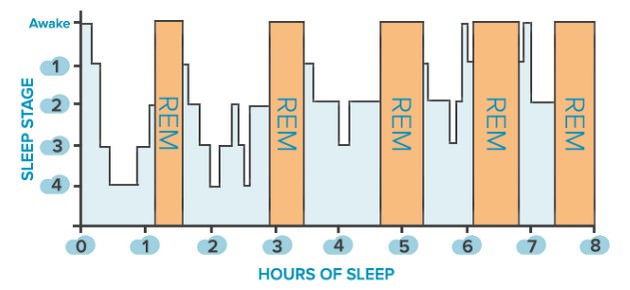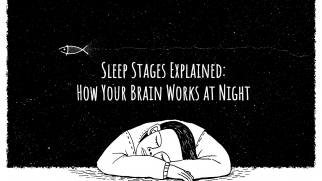Sleep Stages Explained: How Your Brain Works at Night
by | Last UpdatedSleep is a mysterious phenomenon.
It helps us rest and restore, but there’s still a lot going on when we sleep.
Aren’t you curious to learn what happens exactly? Do you know what sleep stages your body goes through every night?
I bet you will be surprised. Let’s dive right in!

How Sleep Stages Work
You probably realize how complicated humans are. I mean, a human organism is a complex system. However, it doesn’t mean it works randomly and chaotically. Our bodies work in a special rhythm, following a certain routine over and over again.
It is the same with sleep. Every time we are in the arms of Morpheus, our brain and body go through the same cycle of sleep stages.
Now, you may be wondering “How many stages of sleep are there? Don’t we just… fall asleep and that’s it?” No, sleep is a complex process, and it involves 5 different stages. The first four stages of sleep belong to the non-REM group, and the fifth one is the REM sleep stage.

Let’s take a closer look at all of them, starting with the non-REM group:
- Stage 1: the lightest form of sleep, kind of a transition between being awake and falling asleep. During this stage, you can drift off and wake up multiple times. It’s also very easy to wake someone up during the first sleep stage. At this point, the brain waves frequency starts to decrease slowly.
- Stage 2: the next stage of light sleep. At this point, your eyes stop moving, heart rate slows down a bit, and the body temperature decreases too. Your muscles relax even more, preparing for a deeper sleep. The frequency of the brain waves decreases further, while their amplitude increases. This stage typically lasts for around 10-25 minutes and leads your body to the deep sleep.
- Stages 3 and 4: the deep sleep. They can be united into one group because during these two stages the brain works in the same way. Its waves are characterized by the low frequency and high-amplitude fluctuations called delta waves. That’s why this deep sleep stage is often called delta sleep. Lasting for 20-40 minutes, it allows the body to rest and restore. Breathing and heart rate slow down even more. The body temperature decreases. The blood pressure falls. At this stage, the brain is less responsive to the outside stimuli, which means it may be hard to wake a person up when they are in a deep sleep stage. Besides, this is when people usually sleepwalk or experience night terrors.
Now, moving on to Stage 5 – the REM sleep stage, or the Rapid Eye Movement. This stage is also called paradoxical sleep or active sleep because of the characteristic brain waves during the stage. You see, they are remarkably similar to the brain waves of the awake state. During this stage, a sleeper’s eyes start moving from side to side, which, again, can serve as an indicator of the intense brain activity.
Interestingly enough, the REM stage usually lasts for some time, and then the cycle goes back to the non-REM stages, skipping the first one and jumping to the second stage of the light sleep. However, the duration of the REM stage can vary for each cycle. The first time a person enters the REM stage during sleep, it can last for even a minute, while during each next cycle, the longevity of the stage may increase.
What’s a Sleep Cycle?

Now, let me explain sleep cycles in more detail.
A sleep cycle is basically a period of going through all the sleep stages. You start with the light sleep (Stage 1) and move through the rest (as described above). That’s your sleep cycle.
Typically, one cycle lasts for around 90 minutes. Once it’s over, you go back to the light sleep and everything repeats. Thus, we go through multiple sleep cycles during the night.
“Our brain goes through four different types of brain waves: delta, theta, alpha, and beta. Each type represents a certain speed of the electrical voltages in the brain. The delta type is the slowest one, and it is present during the deep sleep stage.”
Interestingly enough, we spend different amounts of time in each stage depending on the sleep cycle. You see, on average, we can go through 4-6 sleep cycles during the night. For the first 2-3 cycles, our brain spends the majority of the time in the deep non-REM sleep (Stages 3 and 4). However, during the last 2-3 cycles, we spend more time in the REM stage. Amazing, right? This only proves how complex sleep is!
Why REM Sleep Is Important
Look, you must already know that we don’t understand all the aspects concerning sleep. It is complex and we need more time and research to know everything about this phenomenon. So, we cannot say for sure whether REM sleep is actually that important. However, some theories exist, and they sound very convincing:
- Many scientists link the REM stage with an increased production of proteins that contributes to our ability to learn.
- Because during the REM stage our brain often uses our memories, this stage is associated with memory consolidation. And this seems quite logical, especially when we look at how much time we spend in the REM stage at different points in life. You see, small kids spend more time in this stage than old people do. Perhaps, this happens because children learn so much and have a lot to process during REM sleep. Seems quite convincing, doesn’t it? Additionally, research shows that people who are deprived of REM sleep tend to lose their learning and memory skills and perform worse with academic tasks.
“REM sleep is often referred to as the paradoxical sleep. Why? Because our brain and body behave rather contradictory during this stage. While the brain is very active (just like some other body systems), the muscles get more and more relaxed, eventually becoming immobilized.”
- Again, because a baby’s sleep is mostly REM, this stage is linked to the brain and nervous system development.
- Because REM sleep is the deepest stage, it is considered to be the time when our bodies rest and restore the most during the night. This means the REM stage is crucial for our health and well-being.
Now, I came across a few studies saying that listening to classical music before sleep makes for prolonged REM sleep and, hence, better sleep overall. I got excited about the experiments and decided to have my own.
So, today is the 27th day since I started turning on some soothing classical melodies before going to sleep, and here’s what I’ve got:
I have no equipment to see how it affects my brain activity, but I do feel now more rested in the morning than I did feel a month before. Yes, I might have simply programmed myself by autosuggestion, but I think I’m still going to continue listening to music before sleep. Perhaps, the secret is that it reminds me of how my mother used to tell bedtime stories to soothe me to sleep when I was little.
Stages of Sleep and Dreaming
Now, you may be wondering “What about dreaming? When do we dream? Each sleep stage isn’t that long, so when do we actually experience those long, vivid, and sometimes awfully realistic dreams?”
In the majority of cases, this happens during the REM stage. This is quite logical, actually. REM sleep is when our brain is the most active, which means it is able to “produce” all those dreams. In fact, because the REM stage repeats itself throughout the sleep, we can dream multiple times a night. What feels like a long, weird dream in the morning is often just a mess made from pieces of all those multiple dreams we had throughout the entire night.
“We usually perceive sleep as a rather passive process. However, it is known that our brain remains active. That’s why sleep plays a huge role in many brain processes, including the cleanup and memory consolidation.”
Believe it or not, studies say that all people dream. Still, not everyone remembers their dreams.
Another interesting fact:
During the REM stage, our muscles cannot move. Some scientists believe that this is our body’s way to protect us from injuries we can cause by moving and trying to act out the dreams we see in REM sleep.
But why do we dream, you may ask? As sleep science is relatively young, we don’t know much about it, so dreaming is still quite mysterious. But there are some interesting theories, including:
- Sigmund Freud’s theory, which says that we dream to sort through and understand our repressed, unresolved desires and wishes.
- Threat-simulation theory, which suggests that dreaming is actually an old biologically caused defense mechanism. It makes us go through various threatening scenarios when sleeping. Such a simulation enhances the mechanisms we need to survive in the real world. So, basically, what happens during the night is that our brain prepares us for the fight.
- Activation-synthesis theory, which says that our dreams don’t really mean anything. They are just electrical brain impulses that consist of random thoughts and memories we pull from our brain. And when we wake up, we try to put those thoughts and imagery together (thus creating a dream) to make sense of everything.
- Continual-activation theory, which states that dreams are the result of the unconscious part of the brain trying to process our memories. So, the subconscious part of the brain activates during the REM stage and starts processing the info, creating dreams and imagery.
Which of these theories do you support? Do you remember your dreams? Feel free to share your thoughts about sleep and its stages in the comments below!





No Comments